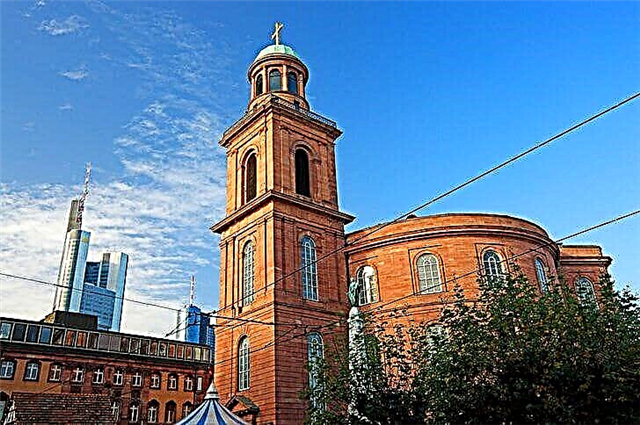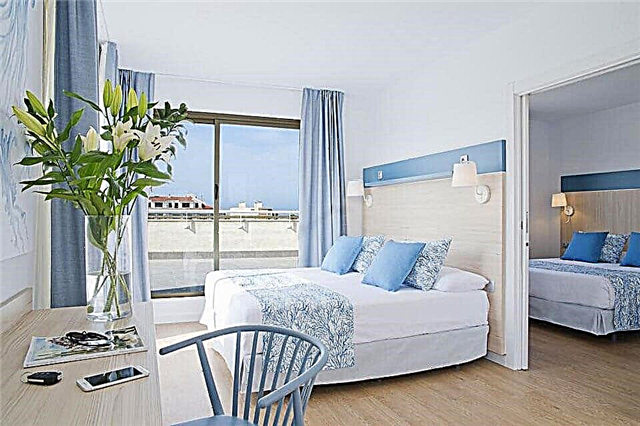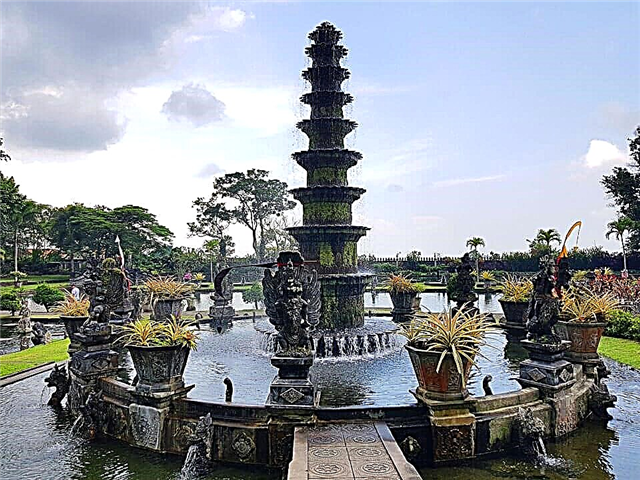Millions of European roads converge in Frankfurt am Main, Germany's largest bus station and the continent's second largest airport. In the distant VIII century, the city was the capital of the East Frankish kingdom, since the 16th century German emperors began to be crowned here.
The historic center of Frankfurt is built up with picturesque half-timbered houses, which form the familiar look, "burgher" trade image of the city. The taverns offer traditional apple wine and Frankfurt sausages with a seven-herb green sauce, a unique culinary invention of the Hesse region.

The best hotels and hotels at affordable prices.
from 500 rubles / day
What to see and where to go in Frankfurt?
The most interesting and beautiful places for walking. Photos and a short description.
Banks Quarter
A modern city block built up with skyscrapers. Here is the headquarters of the European Central Bank and the main offices of other financial institutions. The most famous high-rise buildings in the quarter are the Commerzbank Tower 259 meters high, the Messeturm 256 meters high and the Main Tower 200 meters high. Some skyscrapers are allowed free access. On the top floors there are restaurants and observation decks.

Romerberg Square
The central square of the historic part of Frankfurt am Main, built up with buildings in the architectural style of half-timbered houses. For many centuries, the coronation of German rulers took place here. Römerberg is also famous for the fact that the Frankfurt fair was held here. The historical appearance of the square was restored by 1986. After the destruction of the Second World War, the restorers had to do a lot of work.

Roemer
The building of the Frankfurt City Hall, or rather - a complex of structures, consisting of three buildings. "Römer" means "Roman" in translation. In the 15th century, the city authorities bought out two private houses for their own needs, one of them bore the name “Roman's house”, thus the name “Römer” was assigned to the building of the city council. Inside the town hall there are several magnificent halls where festive receptions were held in honor of the coronation of the rulers.

Hauptwache square
The central city square, where the building of the main guard house of Frankfurt is located. It also housed a prison. The guardhouse lost its military significance after the annexation of the city to Prussia. Later, a police station was located here. Since the beginning of the 20th century, a cafe has been operating in the premises. In the 50s. The guardhouse was rebuilt, and in this form it still exists.

Museum embankment
A section of the embankment on the southern bank of the Main River between the Friedensbrücke and Eiserner Steg bridges. Several museums are located here on a small territory. The place is the cultural center of Frankfurt am Main, and various events are often held here. The most significant of them are the night of museums and the celebration on the museum embankment. On Saturdays, the city's "flea market" takes place on the embankment.

Senckenberg Museum
Museum of Natural History, created at the initiative of the scientific community at the beginning of the 20th century. It is named after I. Senckenberg, a German naturalist and botanist of the 18th century. The museum contains an impressive collection of dinosaur skeletons, one of the most prominent in the world. The fossil remains of ancient animals, birds and the first people are of scientific value.

Museum of icons
The museum collection grew out of a private collection of Orthodox icons by the German physician Schmidt-Voigt. He collected exhibits from all over the world - not only from "Orthodox" territories, but also from African countries. Already in old age, the collector donated his collection to the city. The exposition was housed in the building of a former monastery that belonged to the Teutonic Order.

Museum of applied arts
An extensive exhibition founded in the second half of the 19th century. In order to accommodate all the artifacts of the museum, it took two whole buildings. The first building is a historic villa from 1803, the second is a modern building designed by R. Meyer. The age of individual copies stored in museum funds is more than 6 thousand years. In total, the collection includes about 30 thousand items.

Historical Museum
The collections of the museum are located on the territory of the palace complex of the 12th century. The exhibits tell about the history of Frankfurt am Main, about the development of urban culture. The funds of the museum contain more than 3 thousand paintings, 76 thousand drawings, engravings and maps, about 300 thousand photographs. As well as collections of medieval weapons, furniture, children's toys, coins and clothing.

Goethe House Museum
The former home of the great German thinker, philosopher, writer I.V. Goethe. Within the walls of this house, the genius spent his childhood and youth. Unfortunately, the original interior was destroyed during World War II, but the restorers managed to restore the furnishings. It was here that Goethe created the first sketches of his famous work "Faust".

Old opera
A grandiose Renaissance building built in 1880. The stage opened with the performance of the opera Don Giovanni by V.A. Mozart. This performance was attended by Kaiser Wilhelm I. The building was completely destroyed as a result of air raids on the city during the Second World War. The ruins lay for several decades, because the opera was not going to be restored. But in the end, it was decided to completely reconstruct and restore the building in its historical appearance.

Frankfurt cathedral
The main city temple, which bears the official name of the Imperial Cathedral of St. Bartholomew. It was founded over 800 years ago. In the period from the middle of the 16th to the end of the 18th century, coronations of the rulers of the Holy Roman Empire were held here. Earlier, in the first centuries of our era, on the site of the cathedral there was a palace chapel of the Frankish dynasty of the Merovingians and then the Carolingians who replaced them.

St. Paul's Church
The former Lutheran Church, where the first constitution of a unified Germany was adopted. The building was destroyed during the war and rebuilt in 1948. But by that time the church had already lost its religious functions. Since 1951, the Peace Prize has been awarded here annually, as well as book fairs and literary exhibitions. The church is considered a symbol of German democracy.

Church of St. Justin
One of the oldest churches in Germany. Presumably, the temple appeared in the 9th century. From the 11th century, it passed into the possession of the Dominican Order, and from the 15th century, the brothers of the Order of the Anthonites ruled over the temple. Many ancient Christian relics are kept inside. The Church of St. Justin is surrounded by a garden with medicinal plants, which are actively used by the clergy.

Europaturm
Europatum is the tallest TV tower and skyscraper in Western Europe (337 meters). When it was built in 1979, the building was much smaller - 295 meters, but as a result of reconstruction in 2004, a 42-meter part was added to it. The tower is owned by a German telecommunications company and is closed to the public. Europatum became the first television tower in the city.

Maintower
One of the tallest skyscrapers in the city - 240 meters. The building consists of 56 floors and 4 underground levels. Maintower was built in 1999, it was the first skyscraper in Europe, whose facade was completely covered with glass. There is an observation deck on the roof, where a high-speed elevator leads. The site is popular with tourists, as it offers a magnificent view of the city, and there is also a restaurant.

Eschenheim tower
Medieval fortification, preserved from the 15th century.The Eschenheim Tower was part of the powerful defense system of Frankfurt, consisting of 60 towers and thick walls. It is a neo-Gothic structure with battlements and a central spire. Nowadays, the tower houses a restaurant favored by tourists, and the security room is adapted for a mini-hotel.

Frankfurt Stock Exchange
Reputable German stock exchange founded in the 16th century. In those early days, she provided the needs of the Frankfurt fair. Today the exchange is one of the key platforms in Europe. It is housed in an elegant 19th century mansion in the neo-Renaissance architectural style. In front of the building, according to tradition, there are exchange symbols - sculptures of a bull and a bear.

My Zeil Shopping Center
A modern shopping area with dozens of boutiques, shops, restaurants, entertainment venues, a swimming pool, a sports club, and a multi-level underground garage. The structure was built in 2009, the project budget is 960 million euros. The shopping center harmoniously blended with the modern architecture of Frankfurt and quickly became a popular attraction.

Zeil street
Shopping street, one of the busiest in the city. It is here that all guests of the city rush to shop. Here, a large number of products of recognizable brands are presented. Numerous cafes and restaurants are always filled to capacity with shopping tourists. There is a farmer's market on Konstablerwache square where you can buy local products such as cheese, wine, vegetables and other natural products.

Frankfurt old bridge
The structure connects the Old Town and Sachsenhausen. Until the 70s. It was the only crossing of the Main River in the 19th century. The bridge appeared in the Middle Ages, since then it has been rebuilt many times. A legend is connected with him: the devil offered the help of the master who built the bridge. In return, he asked for the soul of the first person to cross the crossing, but the cock was the first to cross the bridge, so the demon got away with nothing.

Eiserner-Steg pedestrian bridge
Crossing the Main River, built in the 19th century, and eventually turned into a city landmark. The bridge was erected as a result of an urgent need, as more paths were needed to connect the city center with its southern districts. As a result of increased public pressure on the magistrate, the authorities approved the project and found funding.

Frankfurt Zoo
The zoological garden is located in the city center. It owes its existence and prosperity to the active creative work of the director B. Grzimek, who managed to restore the zoo after a devastating war. Today, over 4 thousand animals (400 species in total) live on the territory of the zoo. Popular entertainment includes a visit to the pavilion of nocturnal animals, where you can watch the life of aardvarks and bats.

Bethmann Park
City park, laid out with the financial assistance of the Bethmann family of bankers. The highlights of the park are the chess playground, where a huge playing field is laid out right on the asphalt, and the Chinese garden, which is planned in strict accordance with the principles of Feng Shui. The park's territory is decorated with flower beds, shady alleys and decorative lawns, among which it is pleasant to spend warm summer evenings.

Palm garden
The botanical garden, covering an area of 22 hectares, is considered one of the largest in Germany. The garden was opened in 1871; H. Sismayer worked on the landscape design of the area. Almost 9 hectares of territory are occupied by palm trees of all kinds, hence the name "Palmgarten" (Palm Garden). The park space is intended for a relaxing family vacation or leisurely walks.












